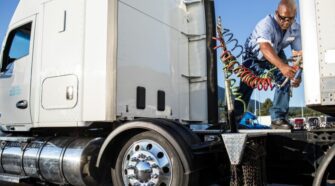

Vehicle technology has come a long way in a short period of time – for both passenger vehicles and semi trucks. In just the last 30 or so years, there’s been the launch of Bluetooth technology and the related in-car call systems, the rise of modern-day GPS units, and then Google and Apple Maps, keyless entry and push-button starts. Now we’re moving into electric and self-driving vehicles. One piece of vehicle-related technology that often goes overlooked by people not in the transportation or logistics industry is telematics. Trucking telematics in particular can be a huge benefit to fleet operations – increasing efficiency, productivity, and safety all while reducing operating costs.

What is Telematics?
The official definition of telematics is “the combination of information technology with telecommunications,” and “the integration of telecommunications networks in vehicles (for collecting data on performance).” Commercial fleet and truck telematics systems can provide a lot of different data points. The use of telecommunications and computer technology can help to monitor, log, and track vehicle and driver performance. Truck telematics systems connect devices such as GPS units, sensors, communication systems, and other computing technology to collect, receive, and transmit data. Data can be collected from a truck driving on a highway in Iowa and be transmitted to fleet headquarters on the east coast.

Truck Telematics Systems: What’s Included?
Depending on the needs of a fleet, or of an owner-operator, trucking telematics can include different technologies designed and integrated to provide the best benefits of telematics. Different telematic companies offer different levels of products that can include the following:
- GPS tracking (for both the trailer and asset tracking for the cargo)
- Vehicle speed
- Trip distance/time
- Tire pressure
- Idling time
- Fuel usage and efficiency
- Harsh braking and turns
- Seat belt usage
- Mechanical data such as battery voltage
Telematics systems can also be integrated with other systems and products, including dash cameras, electronic logging devices (ELDs), dispatching and route optimization software, remote diagnostics, and even weather alerts. Properly integrated and utilized truck telematics systems can benefit fleet owners, drivers, and the clients they work with.

Benefits of Telematics
The key benefits of telematics systems in the trucking and fleet management industry include improvements to driver and road safety, increased efficiency and productivity, reduced operating costs, and even assistance with employee management and payroll.
Improving Safety
Fleet managers can use the data collected by trucking telematics to observe and track trends in driver habits across their fleet. Speeding, harsh braking and quick turns, not wearing a seatbelt, and using the vehicle more than the regulated amount of hours a day can all be tracked. Managers, or even owner-operators tracking their own data, can provide feedback based on the data and driving style. Awareness is the first step in reducing unwanted or dangerous driving habits, and telematics enable that awareness.
Some telematics in trucks can even apply real-time driver coaching, audibly reminding drivers to slow down and utilize other collision prevention methods. Telematics can provide data to fleet managers to observe and track trends in driving habits.
Increased Fuel Efficiency and Productivity
Data provided by telemetrics can include fuel usage and idling time. Managers can use this data to identify areas of waste and implement corrective actions. Telematics in trucks can integrate with route optimization software to ensure the most fuel-efficient route is taken, avoiding unnecessary extra mileage and overpriced fuel stops.
Telematics systems can also help drivers plan for and avoid inclement weather, traffic delays, and road work using real-time GPS information. Dispatchers can quickly work to reroute trucks or dispatch a nearby vehicle to take over a delivery if needed.
Maintenance and Mechanical Tracking
Truck telematics systems can keep tabs on vehicle and part warranties while also monitoring tire pressure, battery status, and engine temperature. Telematics can track and record service records, making it easier to understand when and what maintenance and repairs are needed. Telematics can also integrate with remote diagnostic systems to determine a mechanical problem. This helps keep trucks running properly, and gets them back on the road quickly if there is a problem.
Personnel Management
Telematics in trucks are not just for vehicle and driver data. They can also help improve personnel and payroll management. Owners can see exactly what time a vehicle started, stopped, and idled during the day, therefore accurately tracking an employee’s hours, and reducing the work of the employee and manager in filling out time cards. This can also help ensure compliance with the rules and regulations of how long a driver is allowed to be on the road – and how many breaks they’re required to take. Managers can remind drivers when they are closing in on the maximum allowed time.
Lower Operating Costs
Combining all of the benefits of telematics in the trucking and logistics industry leads to overall reduced operating costs. Increasing safety lowers the number of accidents and unnecessary wear on trucks. This lowers maintenance costs and possible insurance costs or payouts. Monitoring fuel efficiency reduces the amount spent on gas. Tracking maintenance helps to keep a vehicle running smoothly and limits unexpected repair costs. Proper and accurate tracking of hours worked and compliance lowers the chances of a driver needing to pay a Department of Transportation fine for exceeding the limit on their hours of service (HOS).
Telematics is the future of trucking technology. Simple telematics systems with just GPS tracking for example, are relatively inexpensive. Cost of these systems depends on the features and integrations needed, as well as fleet size. No matter what telematics system you use, the return on investment is one of the biggest benefits of telematics. Plus, installing telematics systems in your fleet now only prepares you for the future. The technology isn’t going anywhere – it’s just continuing to improve and evolve while shaping the future of trucking and logistic industries.
Search our site
Related posts


Understanding Trucking Safety Regulations and Compliance

The Importance of Regular Maintenance for Semi Trucks


